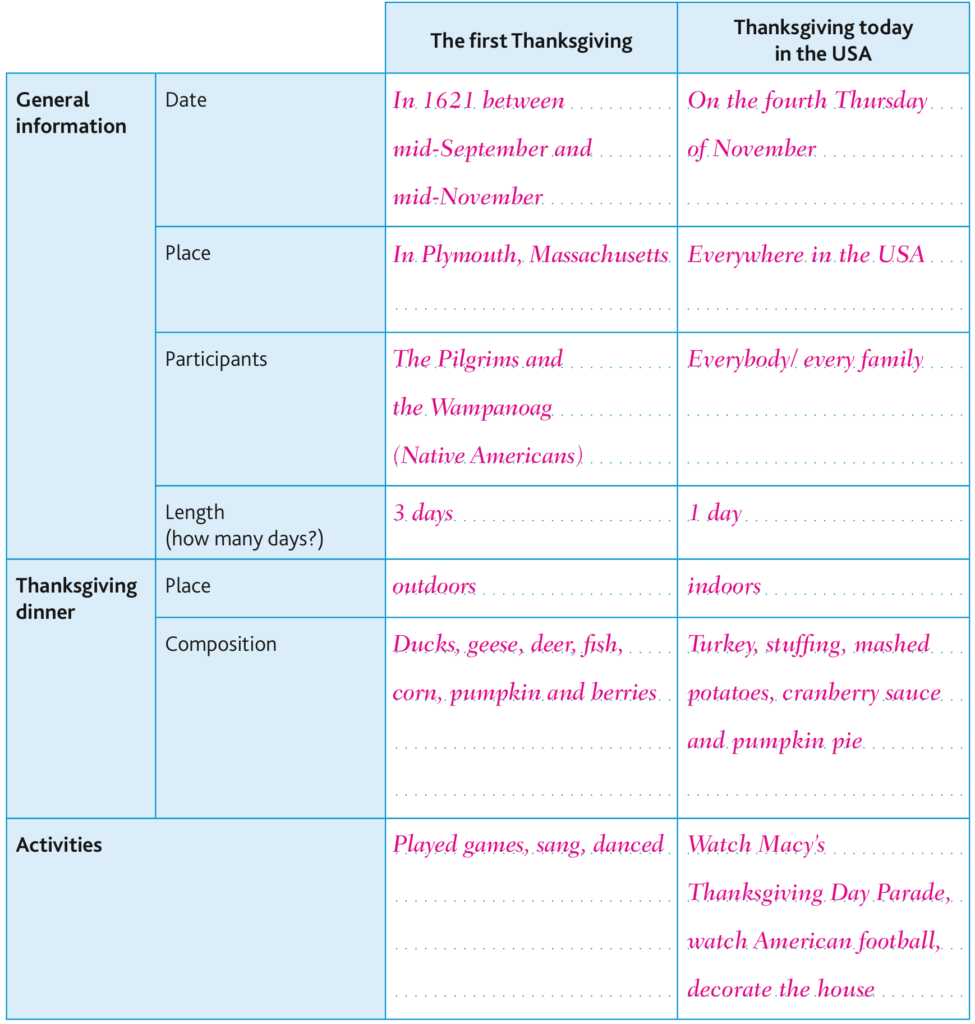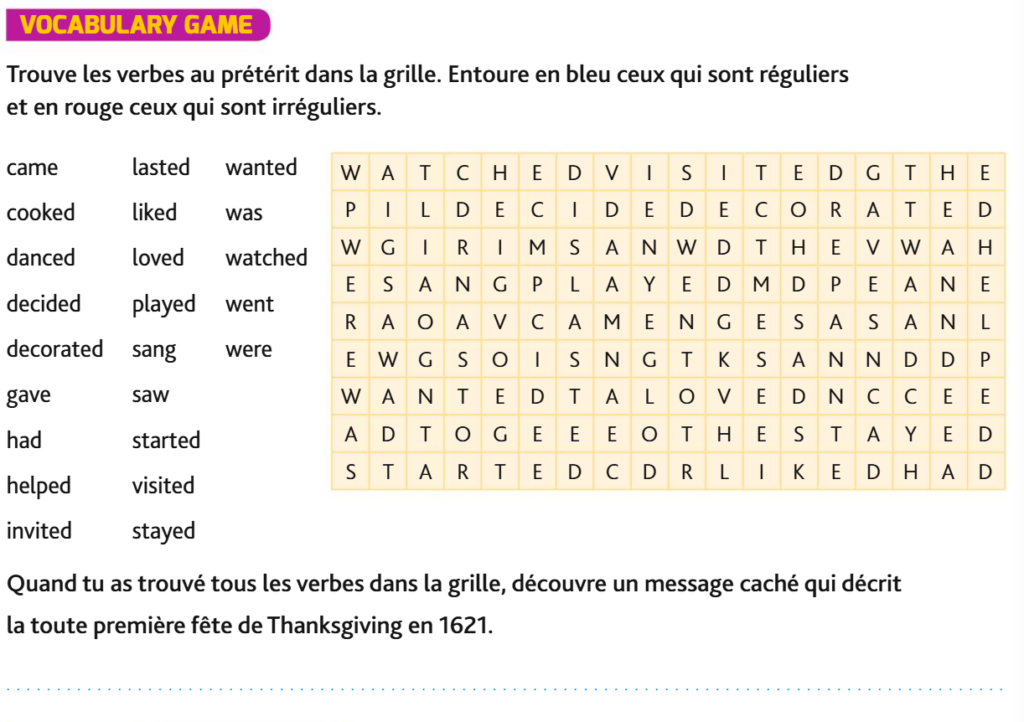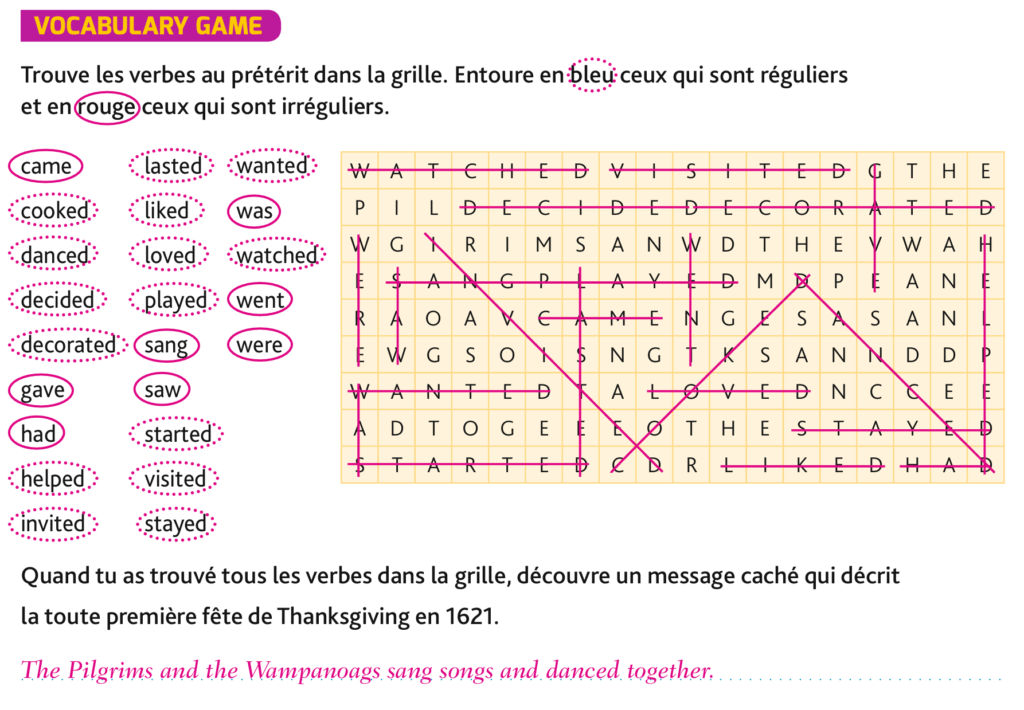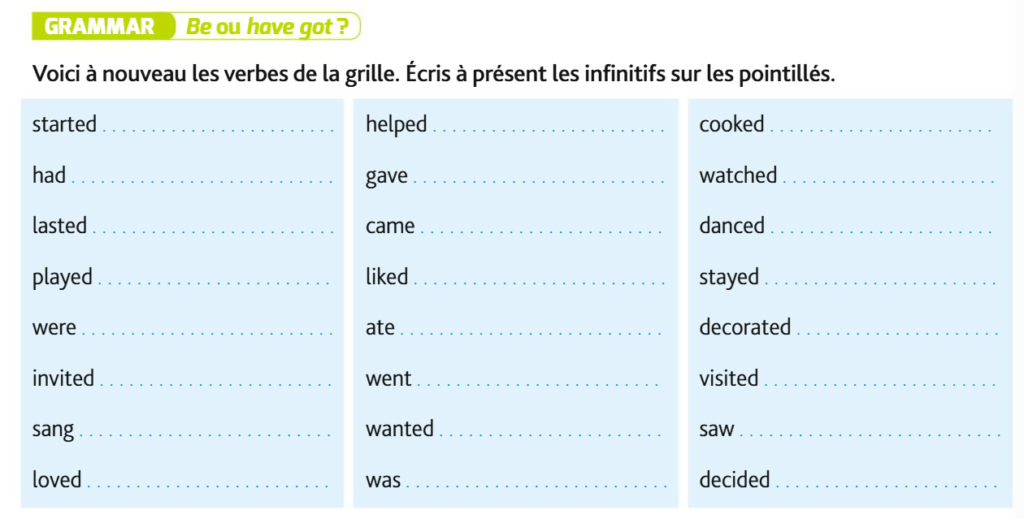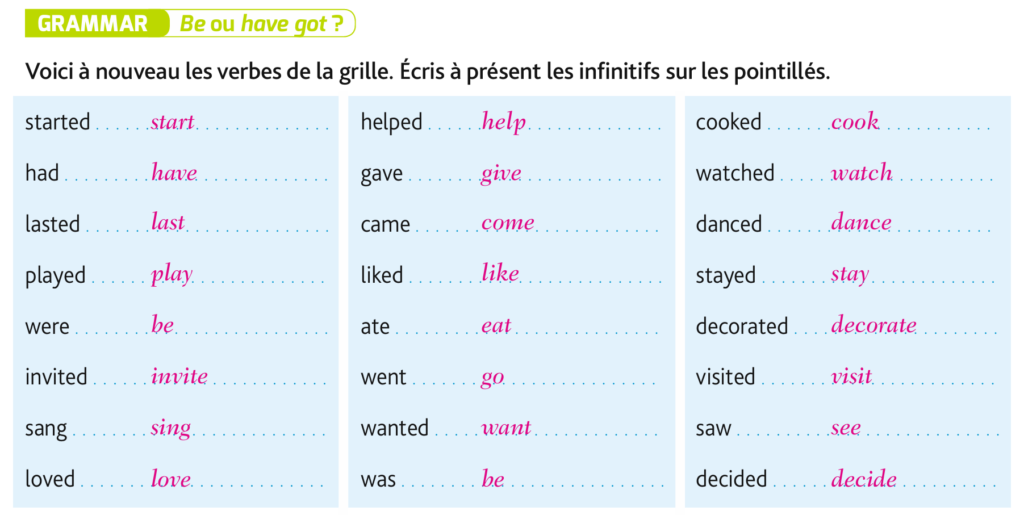We had a great time!
Je vais apprendre
- à comprendre et prendre part à une courte conversation sur un événement passé
- à comprendre et rendre compte d’une expérience passée
- à comprendre une courte biographie
- à échanger sur des personnes célèbres
Je vais découvrir
- l’origine et les traditions de Thanksgiving
- le peuple amérindien et son histoire
Contents
My first thanksgiving
- Nouveau vocabulaire : Thanksgiving
- Compréhension vidéo : My First Thanksgiving
- Questions de compréhension
- Nouveau vocabulaire : Adjectifs
1. Take your copy of Thanksgiving vocabulary.
Can you learn all the vocabulary by heart?
Vocabulary Kit
Thanksgiving & Food
- Thanksgiving = Action de grâce
- Turkey = Dinde
- Cranberries = Canneberges
- Mashed potatoes = Purée de pommes de terre
- Pumpkin pie = Tarte à la citrouille
- Aromas = Arômes
- Scrumptious = Délicieux
Feelings & Friendship
- Grateful / Thankful = Reconnaissant
- Friendship = Amitié
- Memories = Souvenirs
- Pleasure = Plaisir
Descriptive Words (Adjectives & Phrases)
- Sparkling = Scintillant
- Fresh = Frais
- Magical = Magique
- Pleasant = Agréable
- Golden brown = Brun doré
- Soft and light = Moelleux et léger
Expressing Ideas & Gratitude
- Realizing = Prendre conscience
- Overlook = Ignorer / Négliger
- Appreciate = Apprécier
- Blessings = Bénédictions
Poetic & Figurative Language
- Second chances = Seconde chance
- Push comes to shove = Quand les choses deviennent difficiles
- Wealthy = Riche (en argent, bonheur ou amis)
2. Video Comprehension Questions
A: List all the adjectives used in the video: Identify and list all the adjectives mentioned in the video. (e.g., sparkling, fresh, etc.) – check the vocabulary below and recopy the new ones.
B: Find a sentence in the video that talks about friendship: Write down a sentence from the video that discusses friendship and translate it into French.
C: Identify three Thanksgiving dishes mentioned in the video: Which do you prefer and why?
D: What is the main theme of the video? Choose the best answer:
- a) The history of Thanksgiving
- b) The importance of friendship and gratitude
- c) How to cook a Thanksgiving meal
A: List all the adjectives used in the video
Sparkling, fresh, magical, scrumptious, pleasant, appointed, thankful, special, wonderful, tart, sweet, golden brown, spicy sweet, soft, light, extra, wealthy, great, wisdom-filled.
B: Find a sentence in the video that talks about friendship and explain its meaning in your own words
C: Identify three Thanksgiving dishes mentioned in the video
- Turkey
- Mashed potatoes
- Pumpkin pie
D: What is the main theme of the video?
Answer: b) The importance of friendship and gratitude.
Script
One of my biggest dreams has always been to celebrate Thanksgiving accompanied with a bunch of good friends.
And until this day I never really had the chance.
So for you today I present my first Thanksgiving.
Sparkling, yet fresh!
It’s easy to forget that we have so much more
than they can practically sell in a store.
For me, there was something so magical
about the scrumptious aromas and scents filling the room,
and something so pleasant about remembering the pleasure friendship brings.
I believe Thanksgiving is the appointed time for realizing what you’ve got,
because we’re all wealthy when push comes to shove.
Most of all I’m thankful for the second chances,
I’m thankful for my friends who make my life extra special.
Way too often we overlook our blessings,
paying attention to problems instead of being on the lookout
for the bits of pleasure in each hour,
and appreciating the people who bring love and light to everyone.
Making great food accompanied with great friends was invariably a winner.
There was something so wonderful about recreating all the dishes
seen in all the American movies.
Now to finish off these wisdom-filled words,
I’ll share with you a little poem I wrote about Thanksgiving dinner:
*clearing throat*
Taking a turkey and stuffing it fat, with a little this and that.
Then some cranberries, tart and sweet, with the turkey we must eat.
Now to the potatoes, both sweet and white, mashing them till they turn soft and light.
For the dessert, a pumpkin pie, golden brown and spicy sweet, what a fine Thanksgiving treat.
And to my two great friends I got to share Thanksgiving with,
Thanks for all the memories that will dwell in my heart forever.
Vocabulary Kit
Adjectives Used in the Video
- Sparkling = Scintillant
- Fresh = Frais
- Magical = Magique
- Scrumptious = Délicieux
- Pleasant = Agréable
- Appointed = Désigné
- Thankful = Reconnaissant
- Special = Spécial
- Wonderful = Merveilleux
- Tart = Acidulé
- Sweet = Sucré
- Golden brown = Brun doré
- Spicy sweet = Épicé et sucré
- Soft = Moelleux
- Light = Léger
- Extra = Supplémentaire
- Wealthy = Riche
- Great = Formidable
- Wisdom-filled = Plein de sagesse
Emma calls home
- Compréhension audio : Emma calls home
- Goûts et dégoûts : La nourriture de Thanksgiving
Listen to Emma’s phone call
1. Listen to the conversation and pick out the following information.
- Type of document: …………………..
- Who? ………………………
- Topic: ………………………
- Event: ………………………

- Type of document: Phone conversation
- Who? Emma and her Dad
- Topic: Activities and meal on Thanksgiving Day
- Event: Macy’s Thanksgiving Day Parade
2. Listen and take notes about the different events.
a. Write down all the activities you hear in the first column of the grid (there are 10 in total).
| Activity (who? what?) | Time (when?) | Other information |
|---|---|---|
| Hazel and her family went to New York | Yesterday | |
| … | ||
| … | ||
| … | ||
| … | ||
| … | ||
| … | ||
| … | ||
| … |
b. Listen again and pick out information about the date/time of the activities. Fill in the second column of the grid.
c. Listen again and fill in the third column of the grid. Then, recap with your classmates.
| Activity (who? what?) | Time (when?) | Other information |
|---|---|---|
| Hazel’s family travelled to New York | Yesterday | |
| We went to Central Park | In the morning | Hazel’s mother and aunt stayed at home |
| We watched the Macy’s Thanksgiving Day Parade | – | I loved it. |
| Hazel’s mother and aunt cooked the meal | – | – |
| We helped set the table | After the parade | – |
| We decorated the room | – | – |
| We watched an American football game on TV | In the afternoon | I didn’t understand the rules / it was fun |
| We started to eat | At 4pm | We had a great time |
| Everybody gave thanks | After the meal | I’m thankful for my family and Hazel’s family |
3. Listen to the end of the conversation and take notes about the meal.
a. What words do you expect to hear? …………………………………………………………………………
b. Listen and check. Fill in the first line of the grid below.
| Food | Enormous Turkey | ||||
|---|---|---|---|---|---|
| Opinion ❤️❤️ / ❤️ / ❌ |
c. Listen again and find out what Emma liked and didn’t like. Fill in the second line of the grid.
d. Now, recap with your classmates.
| Food | Enormous turkey | Stuffing | Mashed potatoes | Cranberry sauce | Pumpkin pie |
|---|---|---|---|---|---|
| Opinion ❤️❤️ / ❤️ / ❌ | ❤️❤️ | ❤️❤️ | ❤️ | ❌ | ❤️❤️ |
Le prétérit (1)
- Identification des verbes
- Compréhension du passé
- Compréhension orale : conjugaison
Grammar Kit
1. Reading and Identifying Verbs
a. Lis et recopie le dialogue ci-dessous.
b. Souligne tous les groupes verbaux en rouge et entoure en vert le marqueur de temps.
“Yesterday, I visited my cousin in New York and we watched Macy’s Parade in Times Square. We had a great time.”
“Lucky you. I didn’t watch the parade. I helped my mother with dinner.”
- Les groupes verbaux en rouge :
visited, watched, had, didn’t watch, helped - Le marqueur de temps en vert :
Yesterday
Understanding the past tense
c. Lis et complète.
Le dialogue ci-dessus fait référence à des événements ………………., les verbes sont donc au ………………..
Ces événements sont datés et sont totalement coupés du ………………..
À la forme affirmative, pour les verbes réguliers, on ajoute ……….. au verbe à toutes les personnes.
comme ……….. dans le dialogue ci-dessus. Il faut donc les apprendre par cœur !
À la forme négative, on ajoute ……….. juste avant le verbe.
……….. est la forme contractée de l’auxiliaire ……….. et de la négation ………………. correspond à l’auxiliaire do au prétérit.
Le dialogue ci-dessus fait référence à des événements passés, les verbes sont donc au prétérit.
Ces événements sont datés et sont totalement coupés du présent.
À la forme affirmative, pour les verbes réguliers, on ajoute -ed au verbe à toutes les personnes.
comme had dans le dialogue ci-dessus. Il faut donc les apprendre par cœur !
À la forme négative, on ajoute did not (didn’t) juste avant le verbe.
didn’t est la forme contractée de l’auxiliaire did et de la négation not. Cela correspond à l’auxiliaire do au prétérit.
Grammar Kit
Prétérit forme affirmative
- Verbes réguliers : sujet + ………..
- Verbes irréguliers : ……………….
Prétérit forme négative
- Sujet + ……….. + base verbale
Prétérit forme affirmative
- Verbes réguliers : sujet + verbe + -ed
- Verbes irréguliers : forme propre au prétérit (ex: go → went)
Prétérit forme négative
- Sujet + did not (didn’t) + base verbale
2. Écoute et complète
Écoute à nouveau la conversation entre Emma et son père et complète le tableau ci-dessous.
| Verbe en français | Infinitif | Prétérit |
|---|---|---|
| aller | go | |
| avoir | have | |
| understood | ||
| dire | say | |
| donner | give | |
| manger | eat | |
| came | ||
| voir | see |
| Verbe en français | Infinitif | Prétérit |
|---|---|---|
| aller | go | went |
| avoir | have | had |
| comprendre | understand | understood |
| dire | say | said |
| donner | give | gave |
| manger | eat | ate |
| venir | come | came |
| voir | see | saw |
Pronunciation of -ed
- Prononciation de -ed
- Règles de prononciation
- Entraînement oral
1. Écoute et entoure la bonne prononciation de la terminaison -ed
Écoute les phrases suivantes. Pour chaque phrase, dire comment se prononce la terminaison -ed.
- I liked the pumpkin pie.
/ɪd/ /d/ /t/ - I played games with my family.
/ɪd/ /d/ /t/ - He wanted to thank his parents.
/ɪd/ /d/ /t/
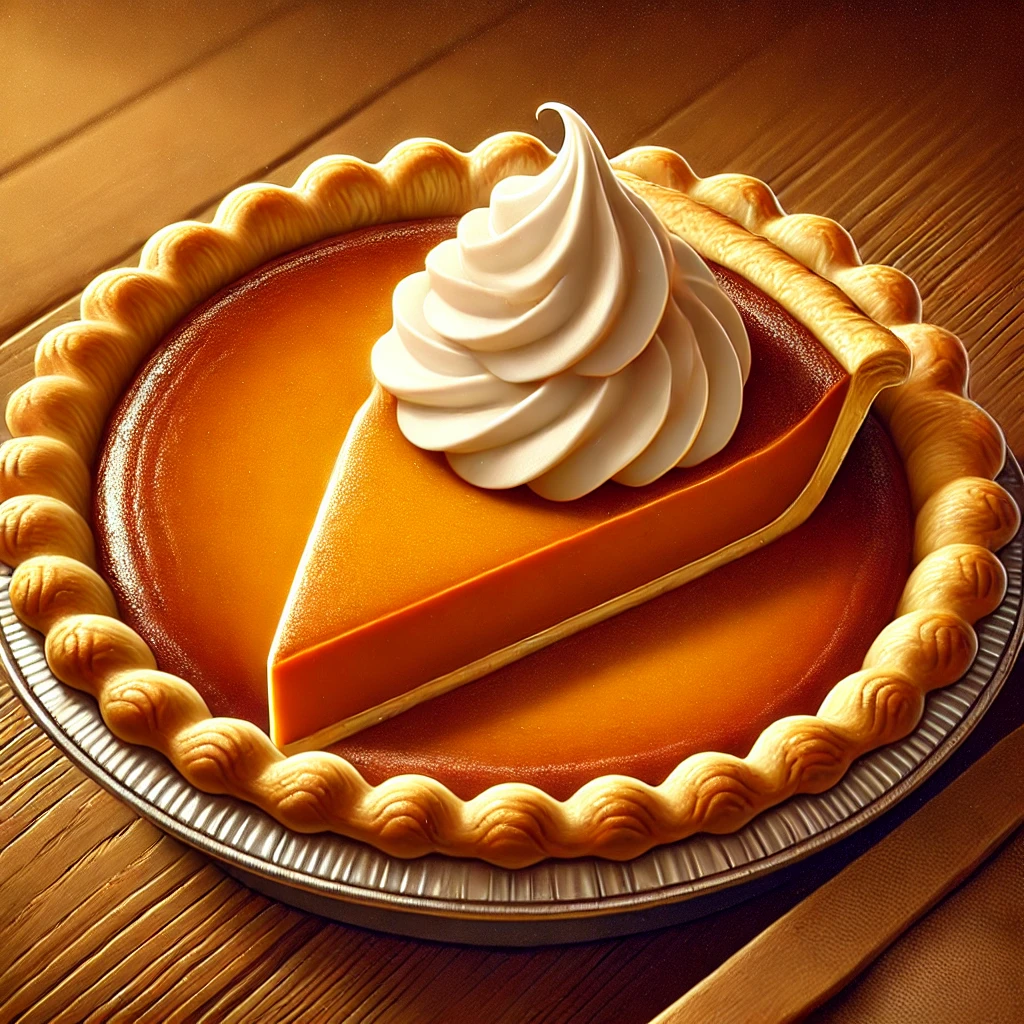
- I liked the pumpkin pie. /t/
- I played games with my family. /d/
- He wanted to thank his parents. /ɪd/
Grammar Kit
Règle de prononciation de la terminaison -ed au prétérit
La terminaison -ed du prétérit se prononce de différentes manières selon la lettre finale du verbe.
/……./, /……./ ou /……./
Grammar Kit
Règle de prononciation de la terminaison -ed au prétérit
La terminaison -ed du prétérit se prononce de différentes manières selon la lettre finale du verbe.
/t/, /d/ ou /ɪd/

2. Copie cette liste de verbes et écris la bonne prononciation de -ed à côté de chaque verbe
(/t/ /d/ /ɪd/)
- visited
- watched
- cooked
- danced
- travelled
- helped
- decorated
- invited
- stayed
- loved
- decided
- visited /ɪd/
- watched /t/
- cooked /t/
- danced /t/
- travelled /d/
- helped /t/
- decorated /ɪd/
- invited /ɪd/
- stayed /d/
- loved /d/
- decided /ɪd/
Grammar Kit
- Lorsque le verbe à l’infinitif se termine par le son /t/ ou /d/, la terminaison -ed se prononce /ɪd/.
- Lorsque le verbe se termine par le son /k/, /s/, /p/, /f/, /ʃ/ (= « ch »), la terminaison -ed se prononce /t/.
- Dans tous les autres cas, la terminaison -ed se prononce /d/.
3. Entraîne-toi à prononcer les phrases suivantes.
Yesterday we celebrated my birthday and I invited a lot of friends.
I liked the party and I received a lot of presents.
We danced, played games and walked to the park.
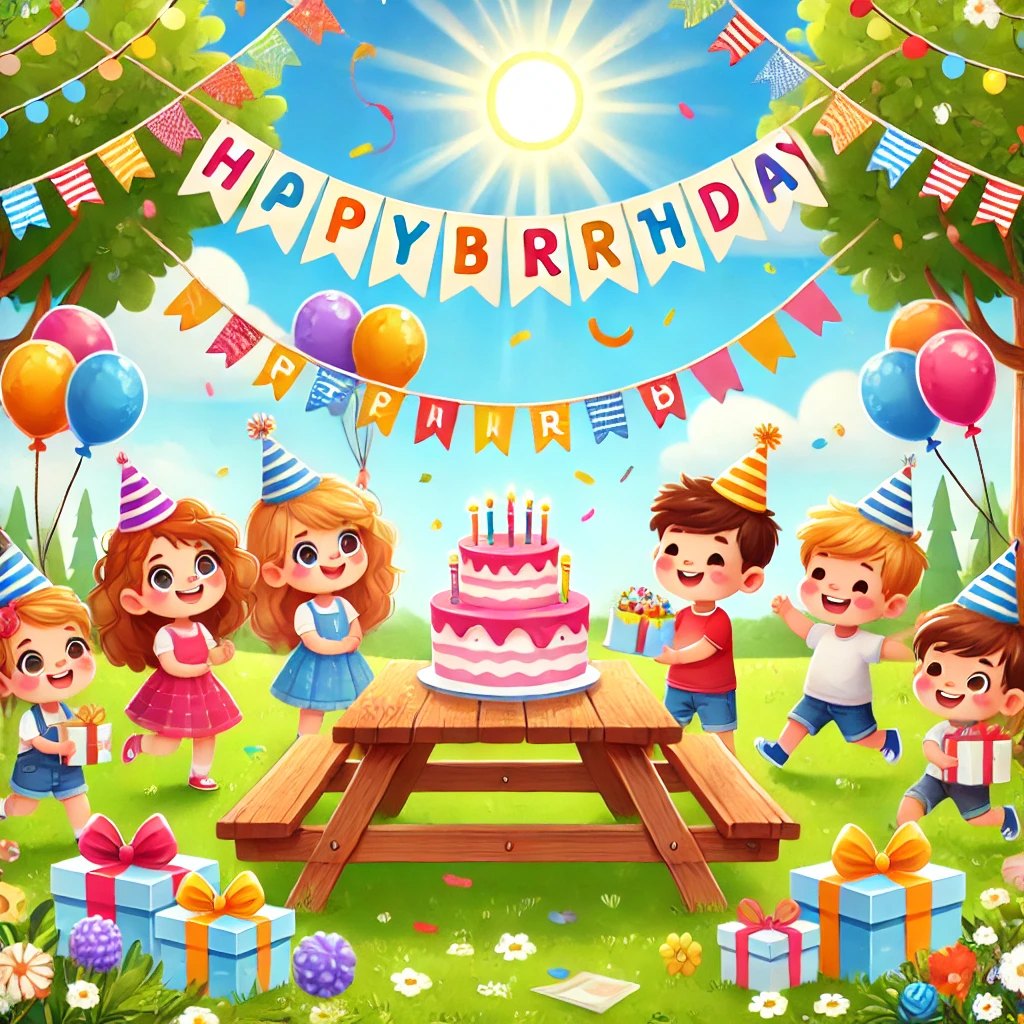
The first Thanksgiving
- Lecture : The First Thanksgiving
- Lexique : Pilgrims, Native Americans, harvest, feast…
- Compréhension écrite
- Repérage d’informations clés (date, lieu, participants, activités)
- Comparaison entre la fête d’origine et Thanksgiving aujourd’hui
Vocabulary Kit
Thanksgiving history
- Native Americans = Indiens d’Amérique
- Pilgrims = Pèlerins (colons anglais arrivés en 1620)
- Harvest = Récolte
- Feast = Festin / repas de fête
- Deer = Cerf
- Goose (pl. geese) = Oie (pl. oies)
Culture box
Les Pèlerins (Pilgrims) ont fui l’Angleterre pour s’installer en Amérique. Grâce à l’aide des Indiens (Native Americans), ils ont fait une bonne récolte et ils ont survécu.
Trucs et astuces
Avant même de lire le texte, aide-toi des indications données par le titre, l’auteur, la date ou encore les dessins. Ces indications te permettront souvent d’identifier le type de document ainsi que le thème abordé.
1. Read your copy of the first Thanksgiving
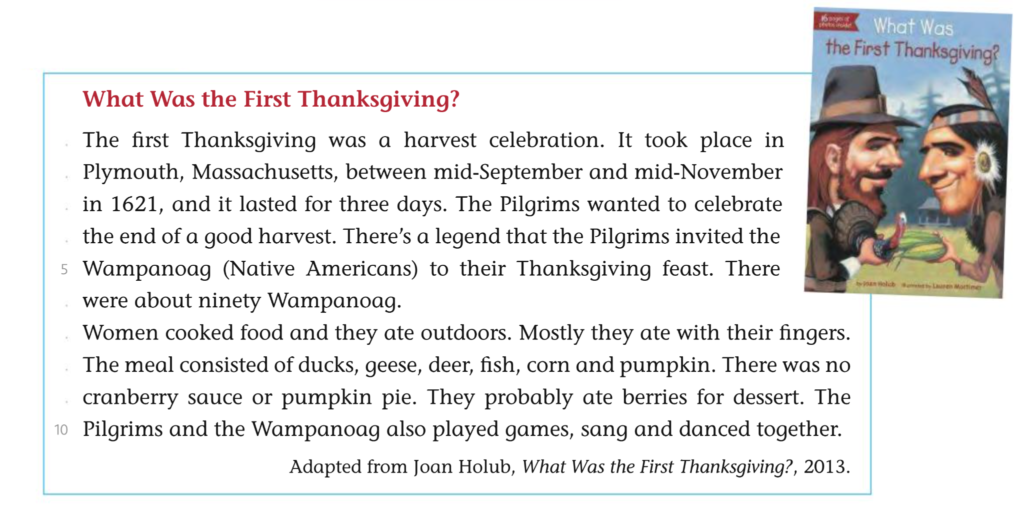
Understanding the Text
Read the text and answer the questions. Copy the questions and write full sentences in your book.
1. What is the topic of the text?
2. Find general information in the text:
- a. The date of the first Thanksgiving
- b. The place where it happened
- c. Who participated
- d. What was the purpose of the celebration
- e. How long it lasted
3. Focus on the second paragraph:
- a. Who prepared the food?
- b. What food was served?
- c. What did they do during the celebration?
4. Compare the first Thanksgiving and Thanksgiving today.
Use the table provided in your handout to help you organise your ideas. Fill in the chart with information from the text and your own knowledge.
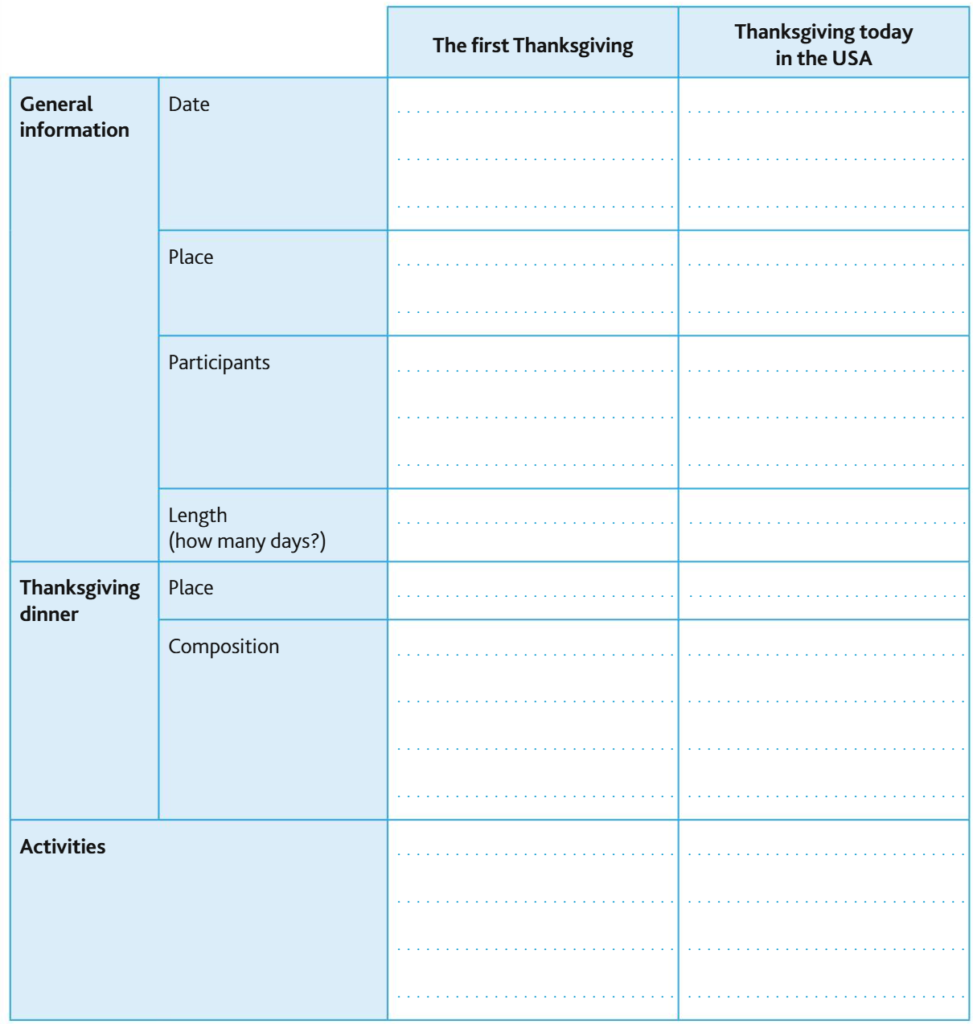
Answers
1. The text is about the first Thanksgiving celebrated in the USA.
2. a. The first Thanksgiving was as some time between mid-September and mid-November in 1621.
b. It happened in Plymouth, Massachusetts
c. Pilgrims and Native Americans participated.
d. The purpose was to celebrate the harvest
e. It lasted three days
3. a. Women prepared the food
b. They ate ducks, geese, deer, fish, corn, pumpkins, and berries
c. They ate, played games, sang, and danced together
4. Comparison table:
